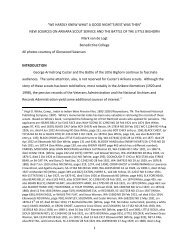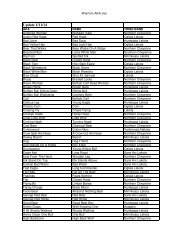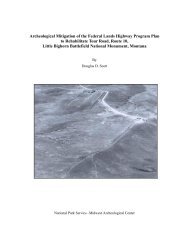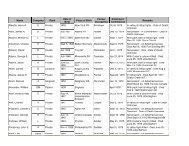Investigating the Oxbows and Testing Metal Detector Efficiency
Investigating the Oxbows and Testing Metal Detector Efficiency
Investigating the Oxbows and Testing Metal Detector Efficiency
Create successful ePaper yourself
Turn your PDF publications into a flip-book with our unique Google optimized e-Paper software.
anging from several dozen pulses per second to over a thous<strong>and</strong>, depending on <strong>the</strong> model or<br />
br<strong>and</strong>.<br />
A sampling circuit in <strong>the</strong> metal detector is set to monitor <strong>the</strong> length of <strong>the</strong> reflected pulse. By<br />
comparing it to <strong>the</strong> expected length, <strong>the</strong> circuit can determine if ano<strong>the</strong>r magnetic field has<br />
caused <strong>the</strong> reflected pulse to take longer to decay. If <strong>the</strong> decay of <strong>the</strong> reflected pulse takes more<br />
than a few microseconds longer than normal, <strong>the</strong>re is probably a metal object at that location.<br />
The sampling circuit sends <strong>the</strong> tiny, weak signals that it monitors to a device called an integrator.<br />
The integrator reads <strong>the</strong> signals from <strong>the</strong> sampling circuit, amplifying <strong>and</strong> converting <strong>the</strong>m to<br />
direct current (DC). The direct current's voltage is connected to an audio circuit, where it is<br />
changed into a tone that <strong>the</strong> metal detector uses to indicate that a target object has been found.<br />
PI metal detectors are poor at discrimination because <strong>the</strong> reflected pulse length of various metals<br />
is not easily separated. However, <strong>the</strong>y are useful in many situations in which VLF-based metal<br />
detectors would have difficulty, such as in areas that have highly conductive material in <strong>the</strong> soil<br />
or general environment. PI systems detect metal much deeper in <strong>the</strong> ground than o<strong>the</strong>r systems.<br />
The detectors employed during <strong>the</strong> oxbow inventory <strong>and</strong> <strong>the</strong> field test included two models of<br />
VLF machines <strong>and</strong> one PI machine. One VLF machine was <strong>the</strong> Tesoro Super TRAQ with a 10<br />
inch concentrically wound elliptical coil. The Super TRAQ operates on <strong>the</strong> 17.8 kHz frequency.<br />
The machines were operated in all metal mode. The o<strong>the</strong>r VLF machine type was <strong>the</strong> Minelab<br />
Explorer II that operates on 28 frequencies simultaneously, 1.5 kHz to 100 kHz. One Explorer II<br />
used a 10.5 inch double D wound coil <strong>and</strong> <strong>the</strong> o<strong>the</strong>r a Coiltek Joey 10 inch elliptical double D<br />
wound coil. The double D coil technology is essentially two D-shaped windings set side by side.<br />
The double D coil form minimizes ground mineralization allowing for greater depth <strong>and</strong> clearer<br />
signal return. The machines were operated in all metal mode. The PI machine was a Minelab<br />
GPX 4000 using a Coiltek Wallaby 17 inch elliptical mono coil.<br />
Oxbow <strong>Metal</strong> Detecting Results<br />
The sou<strong>the</strong>rn or upper oxbow (Figure 4), <strong>the</strong> one that is threatened to be cut off by <strong>the</strong> river, was<br />
<strong>the</strong> first area metal detected. A narrow <strong>and</strong> actively eroding strip or neck of l<strong>and</strong> connects <strong>the</strong><br />
oxbow to <strong>the</strong> higher terraces along <strong>the</strong> park boundary fence. The neck is vegetated with grasses<br />
<strong>and</strong> sagebrush <strong>and</strong> was relatively easy to detect. The main oxbow element is a roughly oval<br />
shaped piece of l<strong>and</strong> around which <strong>the</strong> Little Bighorn River me<strong>and</strong>ers in a broad loop. The<br />
oxbow is a floodplain, <strong>and</strong> in geomorphologic terms a T-0 terrace. It is densely vegetated with<br />
low brush <strong>and</strong> cottonwoods. There is significant deadfall in <strong>the</strong> brushy areas. The dense<br />
vegetation precluded all but <strong>the</strong> most r<strong>and</strong>om metal detector sweeps as <strong>the</strong> team could not swing<br />
<strong>the</strong> detectors nor reach <strong>the</strong> ground surface with <strong>the</strong> coils in most areas. The r<strong>and</strong>om detector<br />
sweeps of <strong>the</strong> heavily vegetated areas produced no metal targets with <strong>the</strong> VLF or PI machines.<br />
The metal detector sweeps of <strong>the</strong> neck produced all of <strong>the</strong> metal finds on <strong>the</strong> sou<strong>the</strong>rn oxbow.<br />
The items found were near surface, ranging in depth from surface to buried about 6cm, <strong>and</strong> all<br />
were located with both <strong>the</strong> VLF <strong>and</strong> PI machines. The finds were 1 .30-30-caliber Remington<br />
unfired cartridge, 2 .30-30-caliber fired Remington cartridge cases, 1 .25-caliber Automatic<br />
pistol fired cartridge case. No headstamp was present on <strong>the</strong> .25-Auto cartridge case. In addition<br />
9








